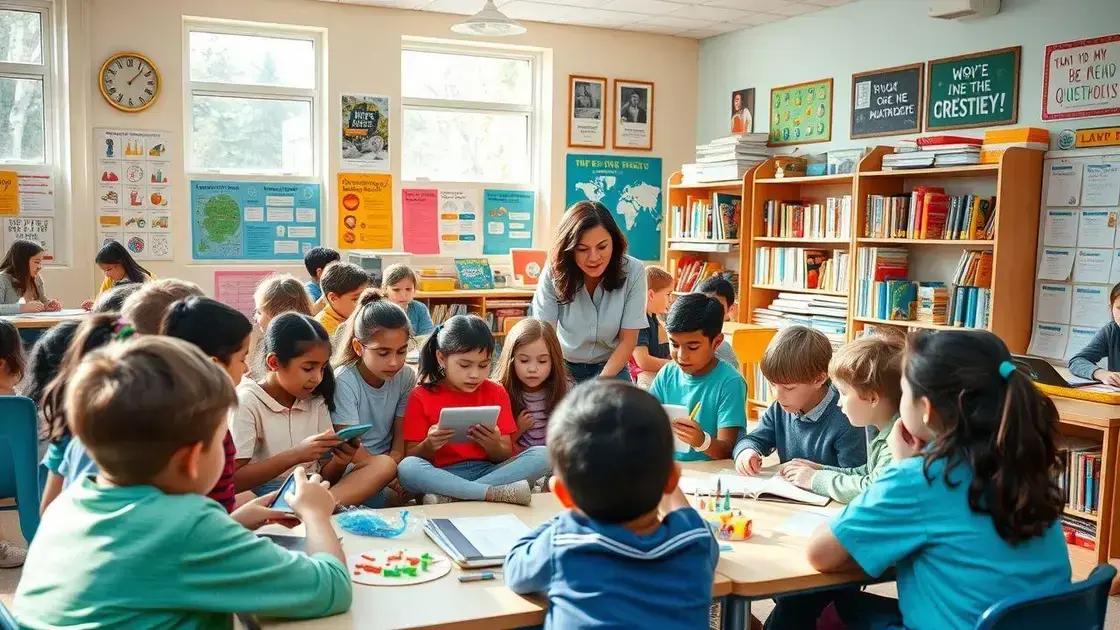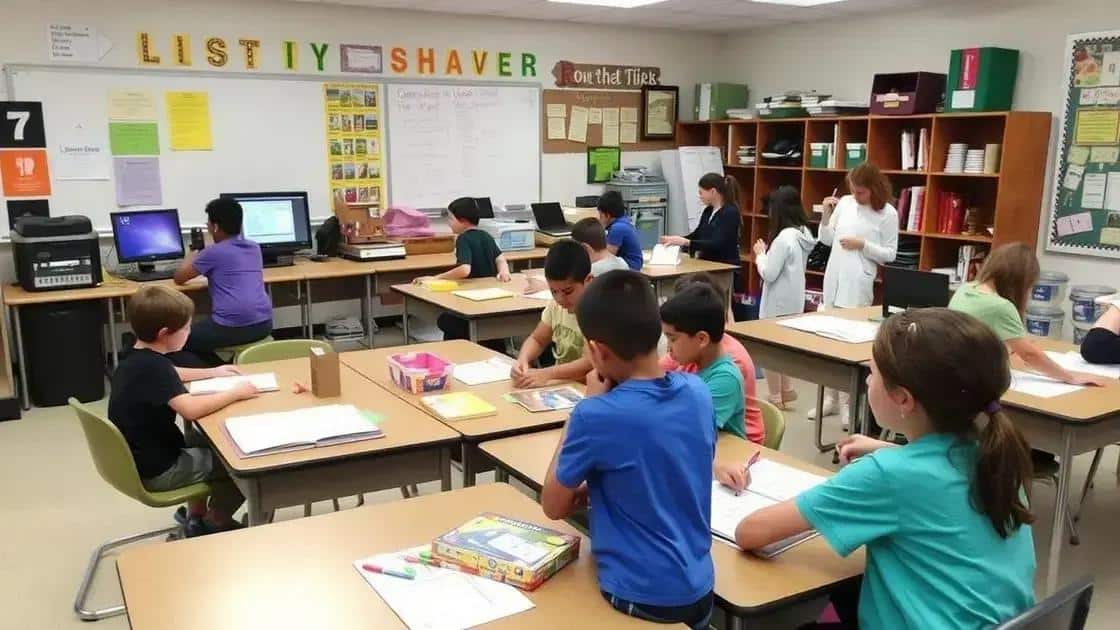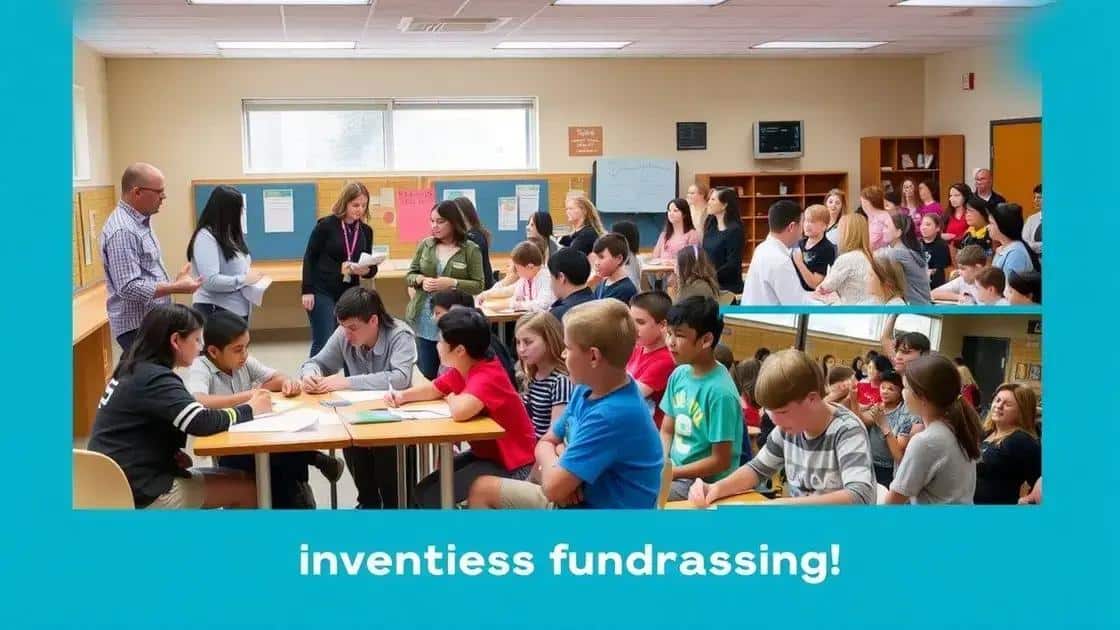Public school funding: why it matters for students

Public school funding relies on local property taxes, state budgets, and federal grants, significantly impacting educational quality and creating disparities in resource availability among districts.
Public school funding is a critical issue that influences the quality of education our children receive. Have you ever wondered how resources directly affect classroom experiences and future opportunities? Let’s dive into this important topic.
Understanding public school funding sources
Understanding the various public school funding sources is crucial for grasping how educational institutions operate. Funding comes from different levels of government and can significantly influence a school’s resources and programs.
Most public school funding originates from three primary sources: local, state, and federal government. These funds are typically allocated based on specific formulas that consider factors like property taxes, student enrollment, and special needs programs.
Local Funding Sources
Local funding is often the largest source for public schools. It usually comes from property taxes collected within the school district.
- Property taxes: These taxes are a stable source of revenue.
- Local bonds: Some districts use bond measures to fund large projects.
- Private donations: Community support can provide additional funding.
This local revenue can create disparities between wealthy and less affluent districts, as property values vary widely. Such inequality can affect resources available to students and educators.
State Funding Sources
State governments provide funding through various programs designed to equalize opportunities across districts. They may use funding formulas that consider demographic factors.
- General Fund: Most state budgets allocate a portion to schools.
- Grants: Specific programs may receive additional funds through competitive grants.
- Equity programs: Certain states have initiatives to help underfunded districts.
States strive to address funding inequality, yet challenges persist. Often, the funding varies significantly from one state to another, affecting the overall quality of education.
Federal Funding Sources
Federal funding represents a smaller portion of public school budgets but is crucial for specific programs.
- Title I: Supports low-income students and schools.
- Individuals with Disabilities Education Act (IDEA): Provides funding for special education.
- National School Lunch Program: Offers financial assistance for student meal programs.
This federal assistance aims to provide equity and support for various educational needs, enhancing student learning experiences across the nation. However, federal funds often come with specific guidelines that schools must follow, complicating their use.
The impact of funding on educational outcomes

The impact of funding on educational outcomes is significant and wide-ranging. Schools with adequate funding can provide better resources, facilities, and support for their students, creating an environment conducive to learning.
When funding is improved, schools can invest in qualified teachers and innovative programs. This, in turn, can lead to higher student achievement and engagement. Research shows that schools with access to substantial funding often perform better in standardized tests compared to those with limited financial resources.
Teacher Quality
One of the key areas that benefit from increased funding is teacher quality. Adequate resources allow schools to hire experienced educators and provide ongoing professional development. This results in:
- Lower teacher turnover rates, which helps maintain stability.
- Access to training that improves teaching methods.
- Ability to implement mentorship programs for novice teachers.
When teachers feel supported and valued, they are more likely to invest deeply in their students’ success.
Access to Resources
In addition, funding greatly influences access to learning materials and technologies. Schools with robust budgets can provide:
- Updated textbooks and educational tools.
- Technology such as computers and software for learning.
- Extracurricular programs that enhance student experiences.
These resources support varied learning styles and promote engagement among students, which is crucial for academic success. The lack of such resources can hinder students’ ability to participate fully in their education.
Furthermore, funding affects school facilities. Well-maintained classrooms and safe environments can increase student attendance and satisfaction. Funding also impacts how schools serve diverse populations, including students with disabilities and those from low-income backgrounds. Programs aimed at these groups often require additional financial support, which can significantly improve educational outcomes.
Challenges in public school funding
The challenges in public school funding are numerous and complex. Many schools struggle with inadequate resources, impacting their ability to provide quality education. Understanding these challenges is crucial for improving the overall education system.
One significant challenge is the reliance on local property taxes for funding. This creates huge disparities between wealthy and low-income districts. Schools in affluent areas can raise substantial funds, while those in economically challenged neighborhoods often fall short. This can lead to a lack of essential resources and programs.
Budget Cuts
Budget cuts are another major hurdle that schools face. Many districts are forced to make difficult decisions that affect teachers and students. These cuts can lead to:
- Fewer teachers and larger class sizes, which reduce individual attention for students.
- Elimination of essential programs such as arts, music, and sports.
- Reduced support services for students with special needs.
These cuts can hurt student performance and hinder their overall educational experience.
Inequitable Funding Formulas
The funding formulas used to distribute state and federal funding can also be inequitable. In many cases, these formulas do not account for the specific needs of diverse student populations. Districts with high numbers of disadvantaged students often receive insufficient funds. This can perpetuate the cycle of poverty and limit opportunities for these students.
Moreover, with increasing costs of living, many schools find it challenging to stretch their limited budgets. This results in insufficient materials, outdated technology, and inadequate facilities. Schools struggle to keep up with inflation and rising costs, further exacerbating the funding problem.
The reliance on short-term grants and donations places additional strain. Schools cannot always count on these funds to be consistent, making it difficult to plan long-term projects or improvements. Additionally, many grants come with restrictions on how the money can be used, limiting flexibility in addressing pressing needs.
Innovative solutions for better funding

Exploring innovative solutions for better funding is essential for addressing the challenges faced by public schools. As funding issues continue to impact education, creative strategies are being implemented to secure and allocate resources more effectively.
One promising approach is forming partnerships with local businesses and organizations. When schools collaborate with community stakeholders, they can gain access to additional financial support and resources. These partnerships can include:
- Sponsorship for school events and programs.
- Internship opportunities for students that enhance career readiness.
- Donations of supplies and materials from local companies.
Such collaborations not only help improve funding but also strengthen community ties and promote student engagement.
Grant Opportunities
Another innovative solution is seeking out grant opportunities designed for educational institutions. Various organizations and foundations offer grants that can provide significant funding for specific needs. By applying for these grants, schools can:
- Obtain funding for technological upgrades.
- Implement new programs focused on the arts, STEM, or special education.
- Enhance teacher training and professional development.
Active pursuit of grant funding can make a substantial difference in a school’s financial health and access to quality education.
Crowdfunding Campaigns
Crowdfunding has gained popularity as a means of raising funds for specific projects. Schools can tap into the power of social media and crowdfunding platforms to engage parents and the community in funding efforts. Successful campaigns can help schools:
- Raise money for specific needs, like sports equipment or classroom renovations.
- Inform the community about funding gaps and encourage contributions.
- Create a sense of ownership and involvement among stakeholders.
This approach can foster a strong community spirit while working toward solving funding challenges.
Additionally, advocating for policy changes at the local and state levels can drive systemic improvements in funding. By pushing for fair funding formulas and advocating for increased education budgets, parents, teachers, and community leaders can work together to create lasting change. When communities band together, they can effectively raise awareness about the need for improved funding and influence decision-makers.
In conclusion, addressing the challenges of public school funding requires a multifaceted approach. By exploring innovative solutions such as partnerships with local businesses, seeking grants, utilizing crowdfunding, and advocating for policy change, schools can enhance their resources. Together, communities can work toward improving educational outcomes and ensuring every student has access to quality education. Collaboration and creativity are key in overcoming financial hurdles and building a brighter future for all students.
FAQ – Frequently Asked Questions about Public School Funding
What are the main sources of public school funding?
Public school funding primarily comes from local property taxes, state budgets, and federal grants, each contributing to the overall funding formula.
How does funding impact educational outcomes?
Higher funding levels often lead to better resources, qualified teachers, and more programs, which can significantly improve student performance and engagement.
What are some innovative solutions for improving school funding?
Innovative solutions include forming partnerships with businesses, applying for grants, launching crowdfunding campaigns, and advocating for policy changes.
What challenges do schools face with funding?
Challenges include reliance on local property taxes, budget cuts, inequitable funding formulas, and rising costs that can strain school resources.






